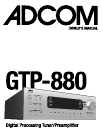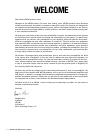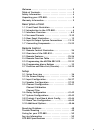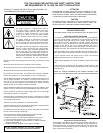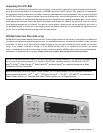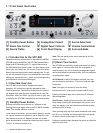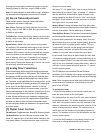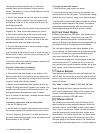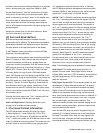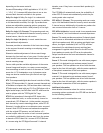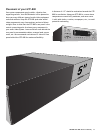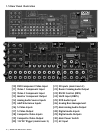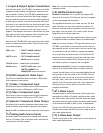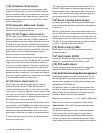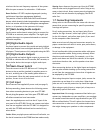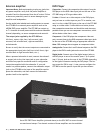
| ADCOM GTP-880 Owner’s Manual6
7ADCOM GTP-880 Owner’s Manual |
Pressing this button again presents the option to set the
listening volume in room two, range is -80dB to 10dB.
Note: If no other selection is made while in setup, selections
will be saved and configuration will exit within 5 seconds.
[
3
]
Bass & Treble Adjustments
These buttons control bass and treble equalization.
Adjustments are made in 2dB steps.
Bass Button: Pressing this button displays current bass
setting, range is from -8dB to +8dB. Use the volume knob
to make an adjustment.
Treble Button: Pressing this button displays current treble
setting, range is from -8dB to +8dB. Use the volume knob
to make an adjustment.
Bypass Button: Defeats the tone controls and provides
an unaltered, full-bandwidth stereo signal to the left and
right channel outputs on the rear panel. However, the
subwoofer DSP crossover remains active and bass frequen-
cies are available at the subwoofer output should you
wish to augment your front L/R speaker’s low frequency
performance. The word “bypass” appears in the front
panel display. Pressing the button again returns the unit to
the previously selected tone settings.
[
4
]
Analog Direct Selections
These buttons select audio inputs from analog multichannel
sources such as DVD Audio or SACD players. The 2 channel but-
ton bypasses the DSP processing for the main selected input.
Bypass 2 Channel mode provides straight two channel listen-
ing. This mode is only applicable with an analog source, as this
input signal bypasses all processing sending a full-range signal
to the front Left and Right channels. However, if the user
has set Subwoofer to be on in the system setup, a Low Pass
Filtered matched signal to the crossover frequency set for the
front left and right channels will be sent to the subwoofer
in order to help reinforce the low-frequency response of the
system. If the user truly has full-range speakers (20Hz-20kHz)
and does not desire to have this bass reinforcement signal,
the user need only disable the subwoofer in the system setup
or in their system.
[
5
]
Digital Tuner Controls
FM/AM Button: Toggles between AM and FM frequency bands.
FM Mode Button: Sets the FM tuner to mono mode. The
letter “M” appears next to the tuner preset number in the
front panel display. Pressing the button again returns the
FM tuner to stereo mode.
The letter “S” will appear ONLY when a stereo station has
been locked by the Digital Tuner. A flashing “S” indicates
that the particular chosen station signal strength is not
strong enough for the Digital Tuner to “lock” onto the ste-
reo signal. In this instance, the user may want to consider
placing the tuner into mono mode.
Memory Button: Pressing this button when FM or AM is select-
ed as the input source memorizes the current station frequency
into one of the presets. You can preset up to 32 stations.
Tuner Up/Down Buttons: The function of these buttons depends
on the tuning mode selected with the tune/preset button.
In preset mode (indicated in the display area): Press the
down button to scroll to a lower number preset; press the
up button to scroll to a higher preset number. This is a
“wrap-around” function, so that going from the highest
number preset, the tuner will go to the lowest preset
number or vice-versa when tuning either up or down.
In tune mode: Press the up or down button for more than
1/2 second to engage automatic tuning respectively up or
down the frequency band. The tuner will search automati-
cally for the first reasonably strong radio station, where it
will stop. Press the down/up button again for 1/2 second
to start searching again.
The GTP-880 tuner can receive AM, FM and FM stereo
broadcasts. Up to 32 stations can be preset and accessed from
the front panel or remote. Stations can also be tuned manually.
Note: Tuner reception cannot take place unless an appro-
priate AM and/or FM antenna is connected to the rear
panel of the GTP-880.
To operate the tuner:
1. Press the tuner button on the remote control once, or
press the tuner button on the front panel.
This indicates that the tuner is in FM, with stereo selected
as the surround mode. The number displayed next to the
tuner text is the preset number currently selected or last
selected, followed by the stereo reception indicator if the
station is being received in stereo. The numbers next to
the FM text are the frequency of the selected preset or
station. The numbers in front of the dB indication are the
current volume setting.
2. Press the AM/FM button on the remote control or the
front panel to change between AM and FM bands.



